Hi, i'm Jackson (He/Him), and welcome to Jackson's Daily Bestiary! This is my secondary blog where everyday i will post about a new mythical being, with detailed descriptions that should help you understand them better as well as illustrations to accompany them, whether they be terrifying monsters, mighty gods, fierce heroes, mysterious animals, the list goes on! I am more than open to requests so feel free to send them through asks, DMs, etc. Have fun!
Don't wanna be here? Send us removal request.
Text
Hey everyone! How have you all been doing? I came to announce that my exams are officially over and thus updates to this blog are gonna pick up again! I'll be getting back into the swing of things very soon. I'll be taking today off to rest as well as work on the next entries. There's definetly some cool stuff coming up, so stay tuned. Until then, have a nice day!
5 notes
·
View notes
Text
Hey everyone, Jackson here! Just came to tell you all that school recently ended for me so i'm gonna be taking a break from this blog for a little while. Stay safe and have a good one!!
5 notes
·
View notes
Text
Jackson's Daily Bestiary #14: Thunderbird
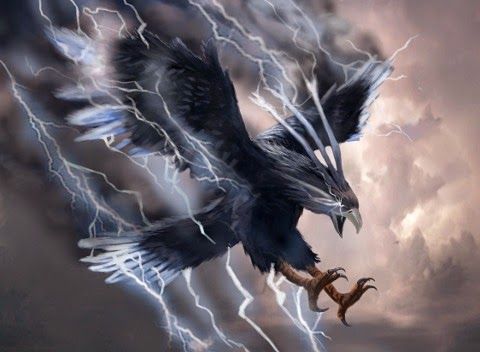
Image credit: https://www.legendsofamerica.com/thunderbird-native-american/
Region of Origin: North America
Thunderbirds are giant birds of Native American mythology, found among the legends of many tribes in North America, particularly those of the Great Lakes region. They are called Thunderbirds because they are said to cause thunder with the flap of their wings and produce lightning from their eyes.
They are said to be large enough to carry off whales in their talons and eat them. Many tribes consider them sacred forces of nature, as they would bring the rain and thus cause vegetation to grow. They may also sometimes be accompanied by lesser spirits in the form of smaller birds and falcon.
Many legends depict them as being constantly engaged in war with evil spirits of the underworld. In Algonquin legends, they are the ancestors of the human race and mortal enemies of the water panther Mishipeshu. In Ojibwe myths, they are moral enforcers created by the culture hero Nanabozho in order to fight underwater spirits.
Sources:
-https://en.m.wikipedia.org/wiki/Thunderbird_(mythology)
-https://www.legendsofamerica.com/thunderbird-native-american/https://
-https://www.britannica.com/topic/thunderbird-mythological-bird
-http://www.native-languages.org/thunderbird.htm
-https://www.historydefined.net/thunderbird/
#jackson's daily bestiary#mythology#folklore#native american mythology#algonquin#ojibwe#Thunderbird#north america#legendary birds
22 notes
·
View notes
Text
Jackson's Daily Bestiary #13: Saci Perere
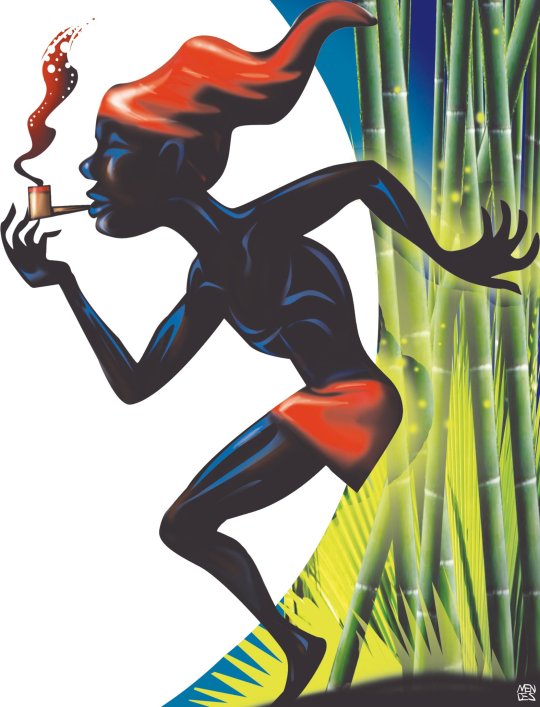
Image credit: https://mythus.fandom.com/wiki/Saci
Region of Origin: Brazil
Saci Perere is a trickster spirit from Brazilian folklore. Originating from southern Brazil, he appears as a short, dark-skinned boy who lives in the forest. He smokes from a tobacco pipe and wears a red cap that allows him to appear and disappear at will or move around in the form of a tornado.
The Saci Perere is primarily known for his love of trickery. He hides children's toys, sets animals loose, curses chicken eggs so they won't hatch, etc. He also has a particular love of causing mischief in the kitchen, where he will break dishes, put insects in food, spill salt and pepper and sour the milk, among others. He is, however, not deadly, simply content with being a nuisance.
It is said that the Saci Perere will grant wishes who those who manage to capture his red hat. However, the Saci's hat is said to have a horrible stench that can never be washed off. Alternatively, one can also throw a blesses rosary into the dust devil he produces and eventually imprison him in a black bottle.
Sources:
-https://en.m.wikipedia.org/wiki/Saci_(Brazilian_folklore)
-https://www.thebrasilians.com/who-is-the-brazilian-folklore-superstar-saci-perere/
-https://samba.tours/2022/01/20/saci-perere-brazilian-folklore/
-https://espressocomsaudade.wordpress.com/2014/05/30/daily-myth-brazilian-saci-perere/https://www.thebrasilians.com/who-is-the-brazilian-folklore-superstar-saci-perere/https://samba.tours/2022/01/20/saci-perere-brazilian-folklore/https://samba.tours/2022/01/20/saci-perere-brazilian-folklore/
#jackson's daily bestiary#mythology#folklore#brazilian mythology#saci perere#trickster#brazil#south america
7 notes
·
View notes
Text
Jackson's Daily Bestiary #12: Mimi
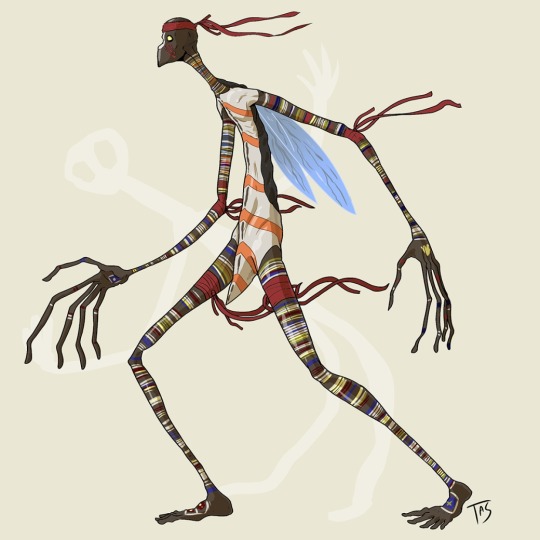
Image credit: https://arcanebeastsandcritters.wordpress.com/2018/05/06/mimi/
Region of Origin: Australia
Mimi (or Mimih) are fairy-like beings from the mythologies of various aboriginal groups of Arnhem Land, Australia. They have extremely thin and elongated bodies, which are at risk of breaking from even the slightest of winds. Because of this, they usually stay inside rock crevices, only coming out on windless days to fish and hunt.
The Mimi are ancestral beings who lived in Australia during the Dreamtime, a mythical period told of in the legends of many, many aboriginal tribes and peoples across Australia. They taught the aborigines many survival skills, such as how to hunt and cook kangaroo meat and, by extension, how to use fire, as well as creative skills, such as painting, through which the aborigines preserve their ancestors' noble deeds.
While they are mostly friendly, Mimi can be mischievous and dangerous to those who disturb them, and they are weary of strangers. The Mimi keep pets, which includes animals such as kangaroos, echidnas, crocodiles and many others. They will become extremely upset if one of their pets is harmed, bringing illness, kidnapping or even killing those who harm their pets. Nonetheless, they are peaceful creatures with a society of their own who promote harmony between Man and Nature.
Sources:
-https://en.m.wikipedia.org/wiki/Mimi_(folklore
-https://www.ancientpages.com/2020/03/26/immortal-mimi-spirits-in-beliefs-of-aborigines-of-arnhem-land
-https://www.aboriginal-art-australia.com/aboriginal-art-library/mimi-spirits/
-https://artmob.com.au/exhibition/mimih-spirits/
#jackson's daily bestiary#mythology#folklore#australia#aboriginal#aboriginal mythology#Australian mythology#Mimi#arnhem land
12 notes
·
View notes
Text
Jackson's Daily Bestiary #11: Orobas
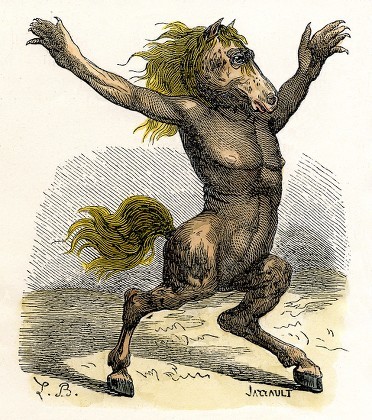
Image credit: https://www.shutterstock.com/editorial/image-editorial/art-various-6051094x
Region of Origin: Israel/Europe
Orobas is one of the 72 demons described in the Ars Goetia, the first part of the demonological grimoire known as the Lesser Key of Solomon. He is listed as the 55th spirit, and is a powerful Great Prince of Hell with command over 20 legions of demons.
He first appears as a horse, but may change into the shape of a man under the conjurer's request. He gives true answers about the past, present and future, as well as divinity, including the creation of the world. He also grants favors and noble titles and can reconcile bonds between the conjurer's friends and even their foes.
Perhaps his most notable trait is his loyalty; he is entirely faithful to his conjurer, as Orobas will never attempt to deceive or harm the conjurer in any way, and will even protect his conjurer from temptation by any other demons. Because of this, Orobas is highly recommendable to summoners who are just starting out.
Sources:
-https://en.m.wikipedia.org/wiki/Orobas
-https://occult-world.com/orobas/
-https://books.google.pt/books?id=tetmEAAAQBAJ&pg=PT5&lpg=PT5&dq=orobas+goetia&source=bl&ots=YuULs24szQ&sig=ACfU3U2l3bbJ70DCL2uw0rvfCn2wftAzAw&hl=en&sa=X&ved=2ahUKEwiHp_fL153_AhVnU6QEHStXBNcQ6AF6BAhUEAI#v=onepage&q=orobas%20goetia&f=false
#jackson's daily bestiary#mythology#folklore#demonology#orobas#ars goetia#dictionnaire infernal#hell#black magic
30 notes
·
View notes
Text
Jackson's Daily Bestiary #10: Alicanto
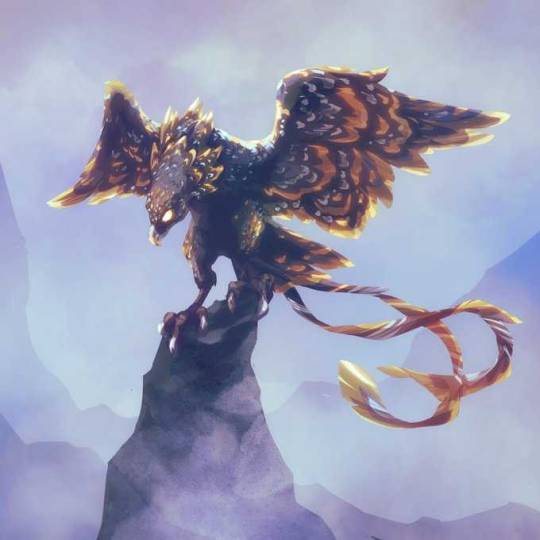
Image credit: https://twitter.com/vamtaro/status/1214454866778607616
Region of origin: Chile
The Alicanto is a legendary bird from Chilean mythology who lives in the Atacama desert. It is said that at night, its wings shine brightly with beautiful metallic colors and its eyes glow radiantly and colorfully. It feeds on ores, and the ores it eats affect the colors of its glow, so for example, if the Alicanto eats a lot of gold, it will gain a golden coloring, or if it eats a lot of silver, it will have the color of silver, and so on, although its wings are also often described to be copper green.
While the Alicanto can fly, it prefers not to, choosing instead to simply walk on the ground. This is because of the weight brought on by its diet of minerals, meaning the less the Alicanto eats the faster it can move. The Alicanto lives in hills and caves filled with many precious minerals. In fact, the Atacama Desert where it lives, which exists in real life, is known for being rich in minerals[1].
Because of this, minners and prospectors often sought out this bird. It is said that if a person successfully manages to follow the Alicanto, they shall be led to a cave or hill, where they will find great amounts of precious ores and thus become wealthy. However, if the person is spotted, the Alicanto will turn off its glow and fly away, leaving the person lost in the dark. Additionally, if the person following the Alicanto is not pure of heart, it will grab the person and drop them to their death.
Sources:
-https://en.m.wikipedia.org/wiki/Alicanto
-https://awasi.com/blog/bedtime-stories-the-alicanto-bird
-https://ztevetevans.wordpress.com/tag/alicanto-bird
-https://occult-world.com/alicanto
[1]-https://en.m.wikipedia.org/wiki/Atacama_Desert#:~:text=The%20Atacama%20Desert%20is%20rich,sodium%20nitrate%2C%20and%20potassium%20salts.
#jackson's daily bestiary#mythology#folklore#chilean#south america#alicanto#legendary birds#chilean mythology
19 notes
·
View notes
Text
Jackson's Daily Bestiary #9: Ammit

Image credit: https://www.artstation.com/artwork/w6Yr4Y
Region of Origin: Egypt
Ammit, also known as Ammut, or Ahemait, was a monstrous creature from egyptian mythology. Her body was an amalgamation of the three largest man-eating animals in Egypt; she had the head of a crocodile, the body of a lion and the hind legs of a hippo.
Ammit lived in the Egyptian underworld of Duat and sat at the feet of the scribe Thoth during the Judgement of the Dead. Anubis would place a heart and the Feather of Truth (which symbolized the goddess Maat) on a weight. If the feather was heavier than the heart, the soul would be deemed pure and allowed to proceed. However, if the heart was heavier than the feather, then the person was deemed to be wicked and unfit to advancing any further.
If this was the case, Ammit would devour the soul, preventing them from advancing any further into the underworld. Because of this, she was also known as the Devourer of the Dead. While some classify her as a goddess, her role is more akin to a demon or monster representative of execution rather than an actual goddess.
Sources:
-https://kids.britannica.com/students/article/Ammit/309834#:~:text=In%20ancient%20Egyptian%20religion%20and,the%20hindquarters%20of%20a%20hippopotamus.
-https://study.com/academy/lesson/ammit-mythology-hieroglyphics-facts.html#:~:text=While%20Ammit%20is%20sometimes%20classified,patron%20of%20death%20and%20execution.
-https://en.m.wikipedia.org/wiki/Ammit
#jackson's daily bestiary#mythology#folklore#egyptian mythology#ancient egypt#ammit#underworld#monster#egypt
16 notes
·
View notes
Text
Jackson's Daily Bestiary #8: Kappa

Image credit: https://www.reddit.com/r/yokai/comments/kldsye/hi_i_am_an_artist_specialised_in_japanese_fantasy/
Region of Origin: Japan
Kappa are mythical creatures from Japanese folklore. They are what is known as a Yokai, a classification for japanese monsters, spirits, etc. The word Kappa means "River child". They have appeared in many japanese folktales and legends, with many regional variants for its name, such as Kawataro, Gataro, etc, and they feature prominently in pop culture to this day.
They are short, reptilian-like yokai with webbed hands, a duck-like bill, a turtle-like shell on their back and a round dish formation on their heads known as a "Sara". This Sara is the source of the Kappa's power and must constantly be filled with water, otherwise the Kappa will be weakened, potentially even dying.
Kappa are mischievous yet dangerous creatures. Despite their small size, they have impressive strength, which they often use to drag people and animals into the water in order to extract a special organ through the anus. This organ is known as "Shirikodama" and is said to contain the human soul. They also often causes diseases and rape women.
They can, however, be defeated. For instance, one can save themselves from a Kappa by throwing a cucumber, which the Kappa are fond of and will chase, thus giving people the chance to escape. One can also defeat a Kappa by making it spill the water on its Sara. This can be done by bowing to a Kappa, who will be forced to bow back, thus spilling the water. They also love sumo wrestling against humans, which they always win at unless they are outsmarted.
Sources:
-https://www.nippon.com/en/japan-topics/b02505/
-https://www.tofugu.com/japan/kappa/
-https://en.m.wikipedia.org/wiki/Kappa_(folklore)
-https://skdesu.com/en/kappa-youkai-juice-and-cucumbers/?_gl=1*14qzouu*_ga*UU9VZUo4NU42YWYwSzZEeW9hT2FxOW9vMExydkVycXIzd0lKX1I3Nkd4Um5BMEhCSE9oOEE5eGRXVUJJcjcySQ..
-https://yokai.com/kappa/
32 notes
·
View notes
Text

10 posts!
Sry for the disjointed ass upload schedule lmao i'm gonna try to actually commit to getting these out on a daily basis sfghjykfz love y'all, stay safe!
1 note
·
View note
Text
Jackson's Daily Bestiary #7: Unicorn

Image credit: https://upload.wikimedia.org/wikipedia/commons/9/91/B%C3%B6cklin_Silence_of_the_forest.jpg
Region of Origin: Europe/Various
Unicorns are fabulous creatures found in many tales and cultures across Europe, though they have their origins in many mythologies, like Mesopotamian, Indian, etc. They resemble beautiful white horses with a single spiraling horn protruding from their forehead. Their horns were said to have many magical traits, such as purifying water, curing diseases, etc.
Unicorns are wild creatures, and they can and will attack if provoked. Nonetheless, they are symbols of purity and innocence, and are fond of virgins, for it is said that only a virgin can capture a Unicorn. Because of this, many medieval texts and bestiaries often made metaphorical connections between Unicorns and the Virgin Mary.
During the Renaissance, people would often pass narwhal horns as unicorn horns so they could sell it to wealthy monarchs. They were present in much medieval imagery, particularly heraldry, and are still staples of fantasy pop culture to this day. Additionally, similar creatures exist in many cultures around the world, such as the chilean Camahueto, the chinese Qilin and the biblical Re'em, among many others.
Sources:
-https://en.m.wikipedia.org/wiki/Unicorn
-https://www.britannica.com/topic/unicorn
-https://mysticbeasts.com/are-unicorns-evil/?utm_content=cmp-true
#jackson's daily bestiary#mythology#folklore#european mythology#unicorn#medieval#magical creatures#fantasy
10 notes
·
View notes
Text
Jackson's Daily Bestiary #6: Dybbuk

Image credit: https://doctorchevlong.artstation.com/projects/58xomW
Region of origin: Israel/Europe
The Dybbuk are spirits from Jewish folklore. The name comes from the Hebrew word 'Dabaq' (דָּבַק), meaning "To cling" or "To attach". They are the misplaced spirits of the dead.
They are spirits who have either escaped or been banished from Gehenna because of their great sins. Thus, they wander the Earth as restless spirits, possessing living people in order to fulfill their unfinished business in life.
Usually, they leave the body after completing their goals, however, there can be occasions where the spirits must instead be excorcised by a Rabbi in order to leave. They are also said to be the cause of mental illnesses and immoral behavior. Belief in Dybbuk became prominent during the 16th-17th century.
Sources:
-https://www.jewishvirtuallibrary.org/dibbuk-dybbuk
-https://www.britannica.com/topic/dybbuk-Jewish-folklore
-https://www.newworldencyclopedia.org/entry/Dybbuk
-https://en.m.wikipedia.org/wiki/Dybbuk
#jackson's daily bestiary#mythology#folklore#jewish#abrahamic religions#ghost#gehenna#underworld#judaism
7 notes
·
View notes
Text
Jackson's Daily Bestiary #5: Jersey Devil

Region of Origin: New Jersey, USA
A demonic creature from the folklore of the US state of New Jersey. It is commonly described as being a flying bipedal beast with a goat-like head and a kangaroo-like body, bat-like wings, horns, hooves for hands and feet and a forked tail.
There are many stories about the Jersey Devil's origins, but the most common one is that of a woman called Mother Leeds. Mother Leeds was a woman living in the area of Pine Barrens who had 12 children. She was poor and her husband was a drunkard and was absent most of the time, so when the 13th child was to be born, Mother Leeds cursed it, fearing the burden of having to raise yet another child.
The baby was normal at first, but in just a few months it had mutated, gaining a kangaroo-like body, sprouting leathery bat wings, gaining a goat head, hooves for hands and feet and a pointy, forked tail.
The Devil attacked and killed everybody in the house, then left through the chimney and into the Pine Barrens forests where it resides today. Many sightings of it are still reported to this day, known for terrifying the locals with its blood-curling screeches and for killing livestock, among other activities.
Sources:
-https://en.m.wikipedia.org/wiki/Jersey_Devil
-https://weirdnj.com/stories/jersey-devil/
-https://pinelandsalliance.org/learn-about-the-pinelands/pinelands-history-and-culture/the-jersey-devil-and-folklore/
-https://www.nj.gov/nj/about/famous/nj_devil.html
#jackson's daily bestiary#mythology#folklore#jersey devil#New Jersey#american folklore#supernatural#cryptid
21 notes
·
View notes
Text
Jackson's Daily Bestiary #4: Valkyrie

Region of origin: Scandinavia
The Valkyries are female figures of Norse mythology. They are a group of all-female warriors who serve Odin, the chief of the aesir gods. They can fly, are incredibly strong and are often seen mounted on horses.
In Norse mythology, those who die in battle may go to one of two halls: Folkvangr, Freya's hall, or Vallhala, Odin's hall. The Valkyries have the sacred duty of guiding souls to Vallhala. They are thus also responsible for choosing who lives or dies in battle.
There, the souls will be trained by the Valkyries every day to become a kind of warrior known as Einherjar, who will be used as an army during Ragnarok, the norse apocalypse. At night, however, the einherjar have a great feast consisting of great amounts of meat and drink.
Sources:
-https://en.m.wikipedia.org/wiki/Valkyrie#:~:text=In%20Norse%20mythology%2C%20a%20valkyrie,or%20once)%20fighters%22).
-https://www.wondriumdaily.com/valkyries-as-seen-in-norse-mythology/#:~:text=Valkyries%20in%20the%20Norse%20Myths&text=They%20are%20mortal%20human%20women,the%20Valkyries%20certain%20supernatural%20powers.
-https://thewarriorlodge.com/blogs/news/valkyries-myth-and-legend
#Jackson's Daily Bestiary#mythology#folklore#valkyrie#norse mythology#european mythology#scandinavia
17 notes
·
View notes
Text
Jackson's Daily Bestiary #3: Djinn
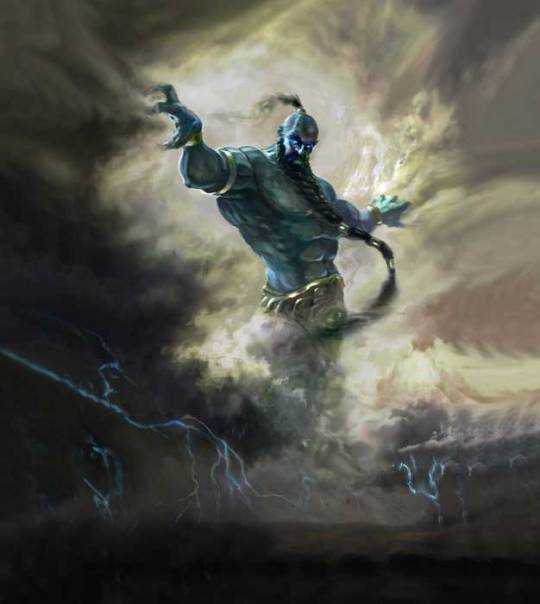
Region of Origin: Arabia
Djinn are invisible creatures which originated from pre-islamic arabian beliefs and were later incorporated into Islamic teachings.
Djinn live on Earth alongside humans, but usually go unseen by them. They have societies of their own and are neither inherently good nor inherently evil. Like humans and angels, Djinn were created by Allah, and thus possess free will. Because of this, Djinn are subject to moral consequences, and can be faithful servants of Allah just as they can be His opposers. This also means that they can have families, jobs, etc.
Djinn are made from smokeless fire and are capable of assuming many different forms, such as various animals. They can be punishing to those who wrong them, but also often help humans, such as by helping them grow spiritually, thus becoming closer to Allah. Djinn are also capable of possessing humans and controlling their actions, but may be warded off by talismans with prayers written on them, or which depict prophets and/or religious heroes.
There are many different types of Djinn, such as the Efreet and the Shaytan, among others.
Sources:
-https://en.m.wikipedia.org/wiki/Jinn
-https://www.britannica.com/topic/jinni
-https://www.vocabulary.com/dictionary/djinn
-https://islamqa.info/en/answers/8214/%C2%A0-do-the-jinn-help-humans-in-some-ways
-https://study.com/academy/lesson/jinn-overview-mythology-names.html
-https://www.metmuseum.org/toah/hd/tali/hd_tali.htm
4 notes
·
View notes
